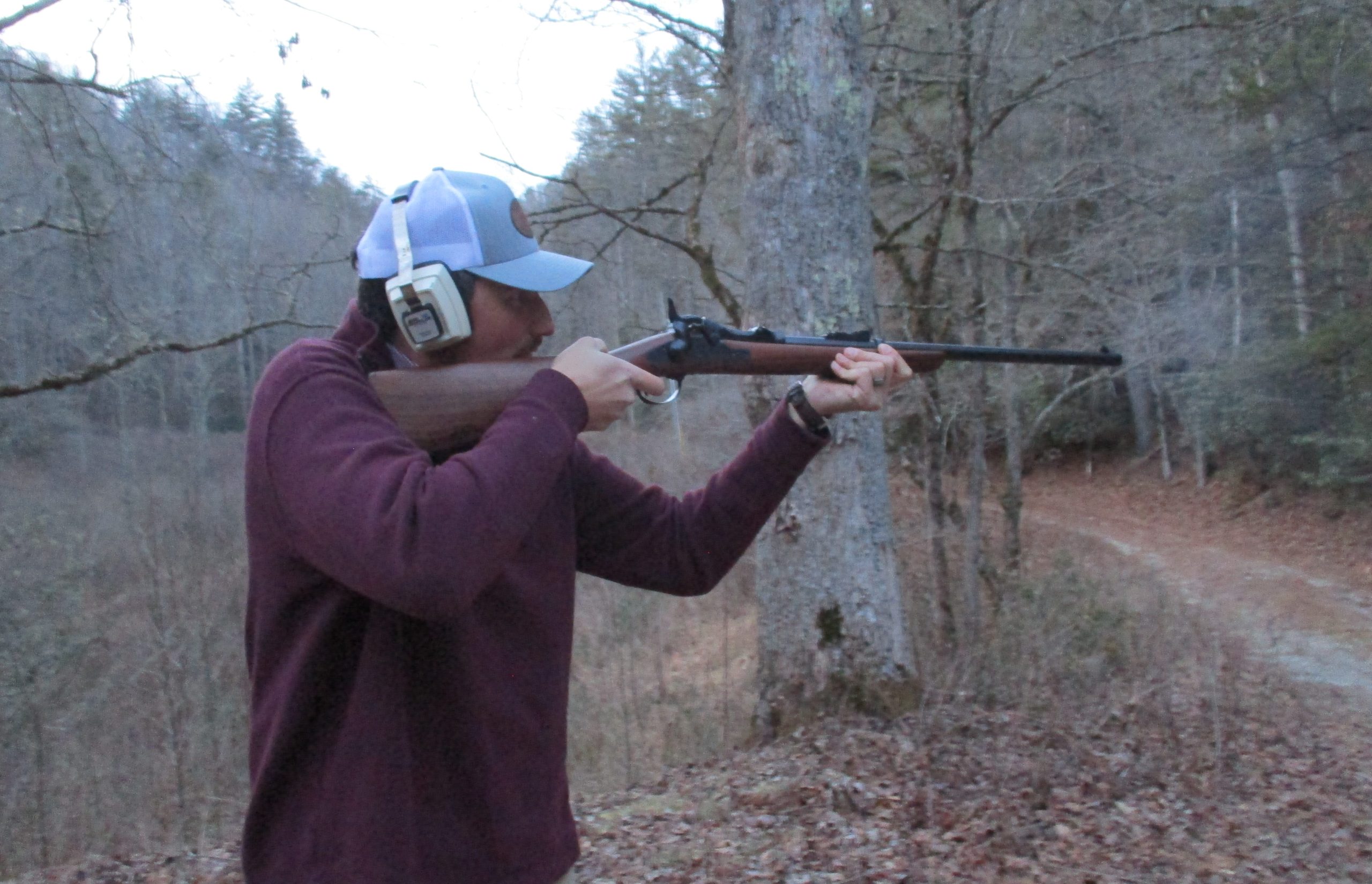
By Jim Dickson | Contributing Writer
Picking up the Uberti replica trapdoor Springfield carbine at Reeves Ace hardware in Clayton, Georgia was like picking up an old friend at the train station.
I have a long association with trapdoor Springfields. Indeed, my first rifle was a Mode 1870 trapdoor in .50-70, a wonderful cartridge but hard to come by since the ammunition companies quit loading it during the Great Depression. The long rifles hang steady, and it is possible to shoot minute of angle groups at 100 yards offhand with a good one. At least for the first two shots anyway. After that fatigue sets in and each subsequent shot tends to double the group size. The carbines are wonderfully fast handling and precise pointers, making them ideal woods hunting guns.
The rifle versions of the trapdoor Springfield came out first chambered for a .58 caliber cartridge like the British Snyder conversions of their rifled muskets. This was followed by the .50-70 and finally the .45-70 which aped the British as they had gone to a .45 caliber, the .577-450.
Cavalry carbines were all .50-70 conversions of Sharps cavalry carbines except for three prototypes in 1869 and Model 1870 trapdoor carbines in .50-70 issued for field trials up until 1873 when the .45-70 round was adopted and the first trapdoor cavalry carbines were made.
Right off the bat they ran into a problem. The 7-pound .45-70 trapdoor carbines were lighter than the full length trapdoor rifles, so they kicked harder. This became a problem for sustained fire and resulted in the cavalry getting a reduced load of 55 grains of black powder instead of the 70 grains in the standard .45-70 load used in the heavier long rifles of the infantry. This gave a reduced velocity of 1,150 fps as opposed to the 1,350 fps of the full power load in the 30-inch barrel found on the rifle.
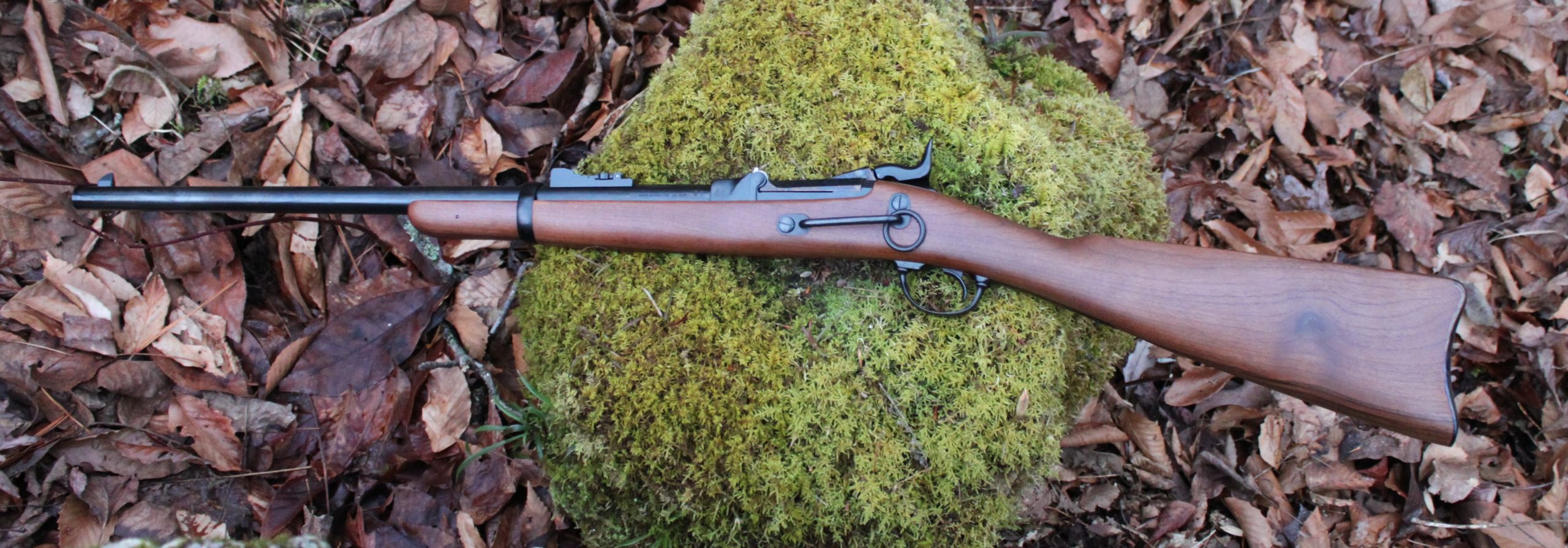
There was another, more serious problem. The first cases were copper instead of brass and the extractor sometimes tore through the rim of the soft copper of a stuck case without extracting it. The problem of cases sticking was greatly magnified by the soft copper’s greater expansion than brass on firing. Dirt or black powder fouling, combined with the plasticity of the soft copper brass molding around the chamber, was a proven formula for stuck cases and the cavalry carbine didn’t have a ramrod to push them out like the infantry rifle had. The cavalryman was left to try to pry out the stuck case with his pocketknife or whatever else he had. Not a good solution.

After the Custer fiasco, this problem reared its head to get some serious attention as this was well documented as a problem at that encounter. The result was a switch to brass cartridge cases, which did not have this problem as the harder brass neither suffered the problem with extractors, nor did it expand into a fouled and/or dirty chamber to the point that it got stuck. This was a problem that Army Ordnance had known about, but it took the attention brought to it by the massacre for Custer’s 7th Cavalry to get something done about it.
Another problem at the Little Big Horn was that some of the guns had fired when the breech was not fully closed resulting in the breech block being violently thrown open with the case head torn off and the case walls stuck in the chamber with no way to remove it. Improperly made and sized ammunition and dirt were both suspected as the cause.
After that the trapdoor Springfield cavalry carbine served well until it was finally replaced by the Krag cavalry carbine as bolt action repeaters took over. National Guard and volunteer units still used trapdoor Springfield rifles and carbines in the Spanish American War and the subsequent Philippine campaign where it faced off with the 7MM Spanish Mauser rifles.
During its tenure as the standard U.S. Cavalry carbine it was well liked for its fast handling qualities and its reliability. These same qualities endeared it to civilian hunters when they became surplus with the first batches sold in 1883. The tradition of the single shot hunting rifle died hard in this country as the legacy of the men armed with single shot rifles opening up this country was not to be denied. Even in recent years I have heard knowledgeable hunters extolling the handling qualities of the .45-70 cavalry carbine. When all you have time for is one swift shot at a fleeing deer, those qualities come to the forefront and the lack of a quick second shot becomes irrelevant.
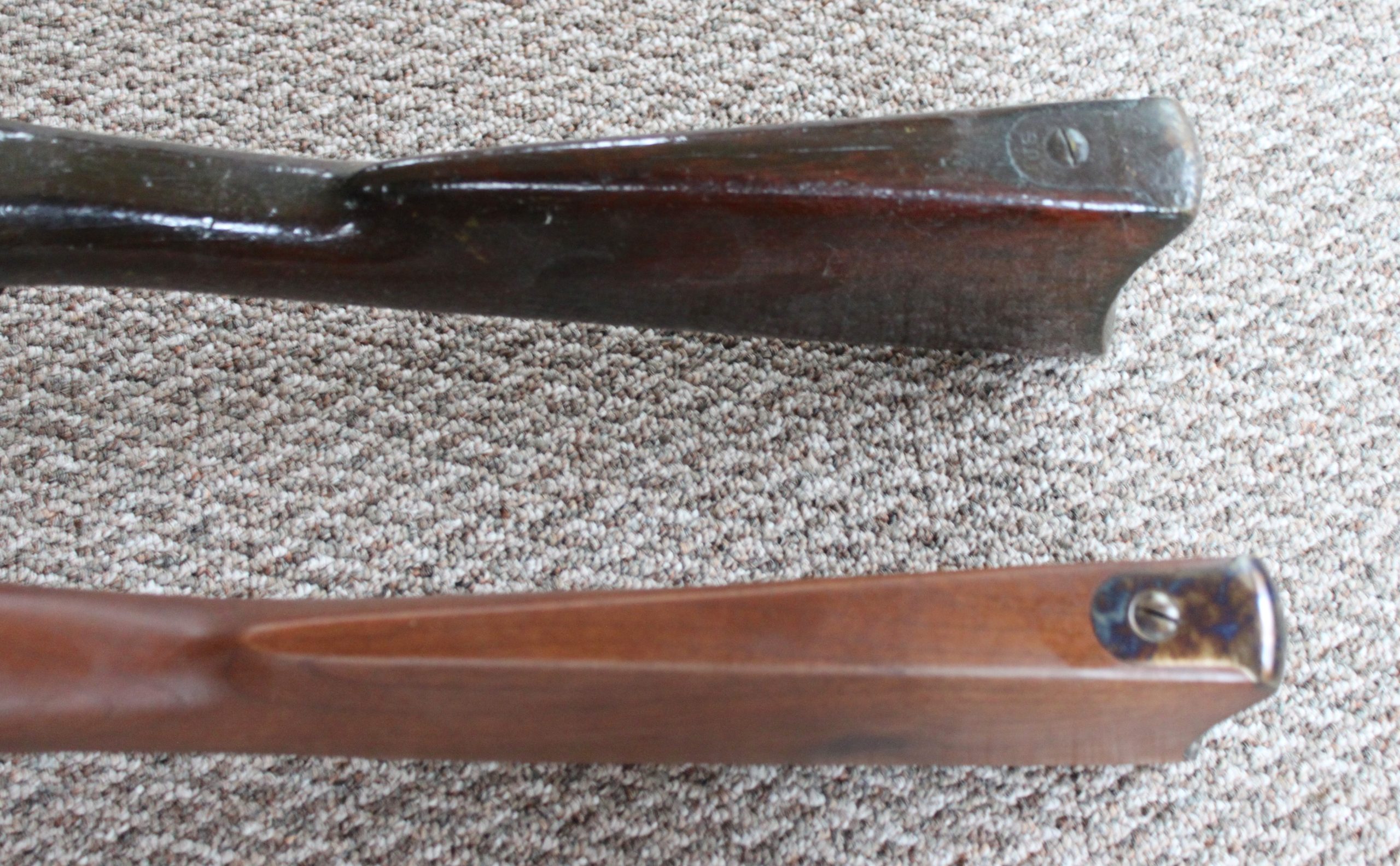
Today when we speak of “The gun that won the West,” we tend to think of either a Colt Single Action Army revolver or a Winchester Model 1873. The truth is the trapdoor Springfield was the gun that won the West because this is the gun the Army used to defeat the plains Indians and force them onto reservations.
With the move from .50-70 to .45-70 vast numbers of .50-70 trapdoor Springfields and Sharps cavalry carbines hit the market at rock bottom prices. These were the most common arms for settlers and also buffalo hunters. Buffalo Bill Cody’s famed Lucretia Borgia was a .50-70 Model 1866 trapdoor Springfield full length rifle. This was the primary rifle he used killing buffalo and earning the name Buffalo Bill. It was also the weapon he used when tracking down and bringing in a horse thief.
Wild Bill Hickok’s favorite rife was a full length .50-70 Model 1870 trapdoor Springfield dating back to when he was a buffalo hunter. Later as a lawman, he used to carry it as he walked down the center of the street so that he could see anyone lying in ambush around the corner of a building better. Hickok so loved this rifle that he wanted it buried with him.
Both Buffalo Bill and Wild Bill Hickok were using their buffalo rifles for gunfighting. Even the buffalo hunters that invested in sporting rifles often ended up choosing guns that could chamber the .50-70 because if you showed up at an army fort and said you were buffalo hunting you would often be given a free case or two of .50-70 ammo as the army wanted the Indians larder, the buffalo, exterminated. Once the Indians were removed the land was open for settlement the West was won and it was the trapdoor Springfields that defeated the Indians and won it.
The main reason the trapdoor Springfield did not receive the honor due it was the use of the Army on the side of the politically strong cattlemen who wanted to graze and drive their herds everywhere against the settlers wanting to fence off their land. This resulted in widespread hatred for the Army and the weapons they used against American citizens who just wanted his property safely fenced off from the cattle baron’s herds.
These settlers learned to hate the army with the same intensity that their forefathers hated the British Redcoats which England had used for police when they ruled America. To give credit to the trapdoor Springfield was to give credit to the Army which had made itself an enemy of the average citizen. The abuse of power of the Army in the post war South and the American West became so bad that eventually they were barred by law from law enforcement with the Posse Comitatus Act of 1878. Thus the commercially available guns used by the civilian population such as the Winchester and the Colt got the glory while the Army rifles were deliberately ignored.
Thus for a long time you could easily find a trapdoor Springfield rifle or carbine. Unfortunately those days are long gone. If you have one that is in unusable condition you can send it to Eugene Golubstov at Lugerman.com for a total restoration that makes it absolutely new condition inside and out. It isn’tcheap but you get what you pay for. Original trapdoors are getting hard to come by. That has opened up the market for replica guns such as this Uberti with an MSRP of $2,249.
Uberti Reproduction
This modern reproduction is finished in a black blue finish with a color casehardened breech block. The trigger pull is crisp at 4 pounds as measured with a Lyman trigger pull gauge from Brownell’s Gunsmithing Supplies. Weight of the sample gun was 7 3/8 pounds and it is 41 ¼ inches long with a 22-inch barrel. There is the traditional sliding ring on a swivel bar on the left side for hooking the carbine to the carbine sling which slung over the cavalryman’s left shoulder. Woods hunters may want to unscrew the swivel bar and take the rattling ring off then put the bar back or at least tie the ring down where it won’t make noise as you move through the woods. The top of the buttstock is left flatter than the originals which were a bit more rounded, particularly towards the action.
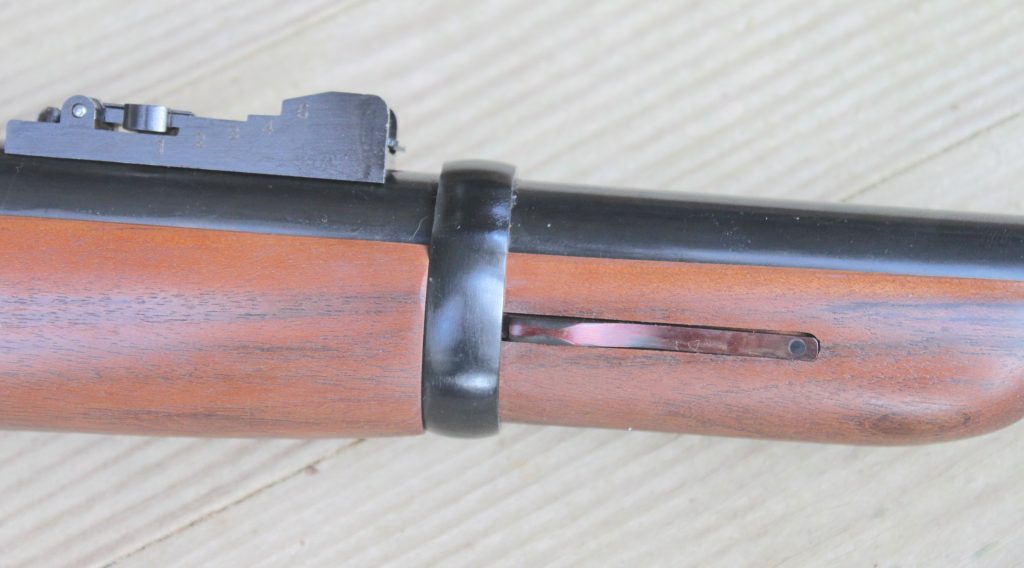
Since a trapdoor Springfield must be cleaned from the muzzle end where the cleaning rod will eventually damage the rifling at the crown it is important to protect the rifling with a brass cleaning rod guide at the muzzle. Army Ordnance used to make their own, but you can get one ready made from J. Dewey Mfg. Co. Inc.
I had 180 rounds to test fire it with consisting of:
- Twenty rounds of Black Hills 405-grain FPL at 1,250 fps, just 100 fps faster than the original carbine load. It provides power without excessive recoil in light guns
- Forty rounds of Steinel Ammunition Co. 500-grain hard cast lead at 1,450 fps. Real charging bear stoppers.
- Eighty rounds of Hornady 325-Grain FTX at 2,000 fps. Flat shooting with a soft plastic pointed tip for better aerodynamic flight it should be noted that the famed .405 Winchester was a 300-grain bullet at about the same velocity as this larger .458 diameter .45-70
- Forty rounds of Remington Core-Lokt JSP at 1,600 fps. This is the load that the .45-70’s reputation was built on with an extra 250 fps for good measure.
Firing it was rather disappointing, though. The barrel band retaining spring on the forend had nearly a 1/16-inch gap between it and the barrel band while the barrel channel in the stock is oversize, resulting in the barrel easily moving from side to side when handled and during firing.
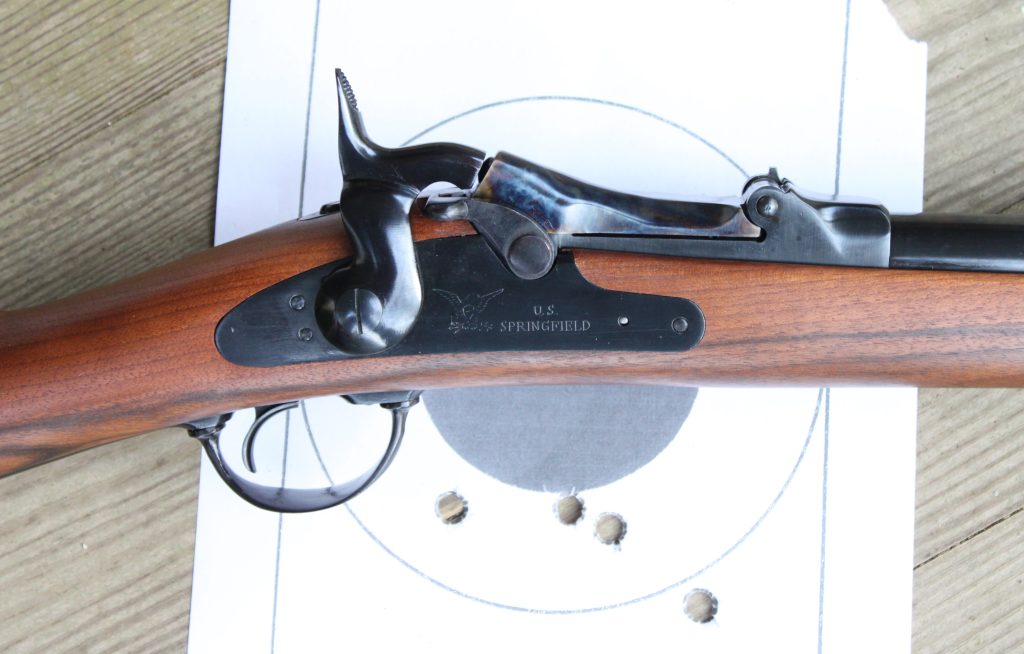
This resulted in a wide horizontal spread of each group.
At other times the rifle strings shots vertically and it also sometimes just shoots a very wide group that looks like a shotgun pattern. That’s why these parts were always tightly fitted on the originals.
If this were my gun instead of a loaner I would have the barrel glass bedded and the barrel band spring end built up to eliminate the problem. No gun can shoot accurately if the barrel and action are moving around in the stock when it fires.
My test rifle shot extremely low for everyone who fired it. The chamber was so tight that cartridges had to be physically pushed completely in and there were failures to extract. Trying to get a stuck case out without a ramrod was a link to Custer’s men at the Little Big Horn that I could do without. This occurred even with the lightest loads.
Unlike the originals which tore through the cartridge case head, the replica extractor did not even leave a mark on the case head when the breech was opened with the cartridge remaining stuck in the barrel. The extractor was not moving those times.
Today the pool of readily available original trapdoor carbines has long dried up. If you want one the Uberti replica offers you a chance to have a new reproduction of one even if it does need a little work once you get it.



